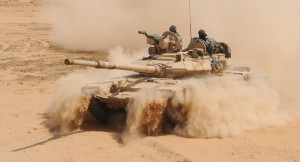With Iran on track to receiving access to about $30 billion of $100 billion in assets previously frozen by sanctions, Russian journalist and military analyst Alexander Sitnikov pondered just how much of the released funds may be spent on upgrading the country’s defense capability, including its tank forces.
In accordance with the Joint Comprehensive Plan of Action (JCPOA), the international agreement on Iran’s nuclear program reached in Vienna last July, Tehran is not allowed to build or test missile systems, or to purchase advanced conventional weapons from abroad. However, Sitnikov added, “it’s important to note that the JCPOA does not deprive Iran of its right to self-defense.”
“This last formulation,” the analyst recalled, “was controversial from the beginning. US Senate Armed Services Committee Chairman John McCain was categorically against lifting the comprehensive arms embargo. Nevertheless, the supporters of only limited restrictions ultimately won on the grounds that older weapons wouldn’t threaten Iran’s neighbors, especially Saudi Arabia.”
Western experts, Sitnikov noted, are in general agreement that Iran’s military potential and fighting capacity have deteriorated significantly as a result of sanctions. The journalist cited IHS Janes defense analyst Ben Moses, who told Politico last year that Iran’s military capabilities are “very weak.”
In fact, the journalist suggested, “the urgent need to carry out a military modernization was the main reason Khamenei agreed to the nuclear deal. Influential Saudi political analyst Jama Khashoggi [had earlier] predicted that if Assad’s army were defeated, mobile detachments of the Islamic State (Daesh/ISIL) would invade Iran and spread chaos there. And dealing with them, the Syrian experience has shown, is only possible with the help of a mobile armored force.”
Last month, commenting on the Sputnik article regarding the possible delivery of Russian T-90s to Iran, Veterans Today magazine managing editor Jim W. Dean lamented that the West’s “stupid sanctions policies” had effectively robbed Western weapons companies of potential weapons contracts for the near future.
“On the whole,” the analyst explained, “the choice of weapons is influenced by many factors, including the fact that the T-90 was created on the basis of the legendary Cold War-era T-72 –the very same tank which was supposed to march toward the English Channel through the Fulda Gap…In the 80s, Western experts considered it a very balanced and cost-effective fighting machine, and more reliable than the T-64, which was not very well liked by Soviet tank crews, to put it mildly.”
“In other words,” Sitnikov explained, “in a real war, when the operation is poorly planned, all tanks, no matter how expensive, will burn. The US now wants $2.4 billion from the Iraqis for the next batch of 170 M1A1s, or approximately the same amount India paid for its 1,000 T-90s.”
In the final analysis, Sitnikov notes, “in a conflict, numbers matter. Out of the 700 old T-72s which Syria bought from the USSR, at least 300 are still in service, despite their obsolete protection and many years of bloody fighting. And what’s important is that in the Syrians’ view, these tanks have played a very important role. In short, Tehran knows what it’s buying.”



